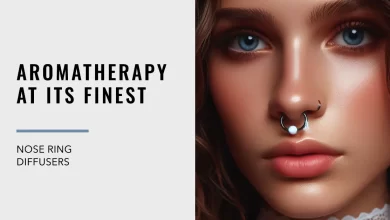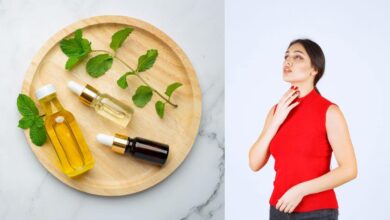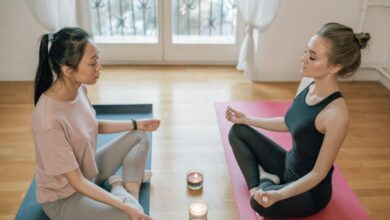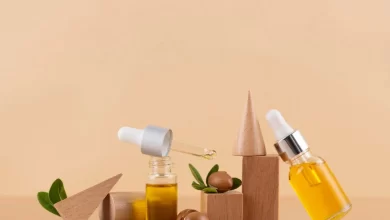Aromatherapy Inhaler: A Gateway to Relaxation, Focus, and Well-Being

In recent years Aromatherapy Inhalers have emerged as a popular tool in respect of aromatherapy, inhalers help in a convenient and portable way to experience the benefits of essential oils. These small, handheld devices allow individuals to inhale the aroma of carefully selected oils, providing a gentle and soothing experience for the mind and body. In this article, we will explore the concept of Aromatherapy Inhalers, delve into their history, discuss the benefits and potential side effects, highlight popular oils for inhalation, and examine their efficacy for relaxation and focus. Additionally, we will provide guidelines for safe usage, and precautions, and discuss the application of Aromatherapy Inhalers for specific conditions.
Table of Contents
Overview of Aromatherapy Inhaler:
These inhalers, also known as essential oil inhalers, are sometimes called fragrant nasal inhalers, or fragrance sticks. Aroma inhalers are small devices used to inhale aromatic essential oils. It typically consists of a tube or container with a cotton wick soaked in a specific essential oil blend. The inhaler is capped to preserve the aroma and prevent evaporation, allowing for repeated use over an extended period.
Ancient Roots of Aromatherapy Inhalers:
The current practice of aromatherapy, including the use of essential oil in inhalation techniques, has its roots in various ancient civilizations where aromatic substances were utilized for their therapeutic properties. While specific evidence of early aromatherapy inhalers is scarce, historical records provide insights into the use of aromatic substances for inhalation purposes.
- Ancient Egypt: Ancient Egyptian civilization, known for its advanced knowledge of medicinal plants, embraced the use of aromatics. They utilized various methods such as burning incense, fumigation, and inhalation of aromatic substances. Fragrant resins, such as frankincense and myrrh, were commonly burned during religious rituals and for medicinal purposes (1).
- Ancient Greece: The Greeks also recognized the therapeutic value of aromatics. The renowned physician Hippocrates, the father of modern medicine, advocated the use of aromatic substances for therapeutic healing. His writings mention the inhalation of fragrant vapors to alleviate respiratory ailments (2).
- Traditional Chinese Medicine: Aromatherapy practices have been an integral part of Traditional Chinese Medicine (TCM) for centuries. In TCM, aromatic substances are used to balance energy, promote well-being, and address various health conditions. Inhalation of aromatic herbs, such as eucalyptus and peppermint, has long been employed to clear the respiratory system (3).
- European Renaissance: During the European Renaissance, interest in aromatic substances and their therapeutic applications resurfaced. Physicians and alchemists explored the use of botanical extracts and distilled essential oils for their medicinal properties. Inhalation techniques were further refined during this period (4).
- Modern Developments: In the 20th century, the field of aromatherapy experienced a resurgence, thanks to the pioneering work of individuals like René-Maurice Gattefossé and Marguerite Maury. Gattefossé, a French chemist, coined the term “aromatherapy” after discovering the healing properties of lavender oil when applied to a burn. Maury, a French biochemist, developed a system of applying essential oils to the skin and inhaling their vapors (5).
Benefits of Aromatherapy Inhalers:
- Relaxation: Aromatherapy inhalers are widely used to promote relaxation, reduce stress, and induce a calm state of mind. Essential oils such as lavender, chamomile, and frankincense are commonly employed for their soothing properties (1).
- Focus and Concentration: Certain essential oils have been associated with enhancing mental clarity, improving focus, and increasing concentration. Rosemary, peppermint, and lemon essential oils are believed to have stimulating effects on the mind (2).
- Mood Enhancement: Inhalation of uplifting essential oils can help elevate mood and create a positive atmosphere. Citrus scents like lemon and orange and floral fragrances such as ylang-ylang and geranium are often used for their mood-enhancing properties (3).
- Respiratory Support: Aromatherapy inhalers containing essential oils like eucalyptus, peppermint, or tea tree can provide relief from nasal congestion and support respiratory health. These oils have expectorant and decongestant properties, helping to clear the airways (4).
- Headache Relief: Peppermint, lavender, and eucalyptus essential oils, when inhaled through an aromatherapy inhaler, may alleviate headaches and migraines. These oils have analgesic and calming effects, which can help reduce headache symptoms (5).
Side Effects of Aromatherapy Inhalers:
- Allergic Reactions: Some individuals may be sensitive or allergic to certain essential oils used in aromatherapy inhalers. It is crucial to perform a patch test before using an aromatherapy inhaler. Apply a small amount of the diluted essential oil blend to the inner forearm, and wait for 24 hours to check for any adverse reactions. You must immediately discontinue and avoid the further use of essential oil in case any redness, itching, swelling, or irritation occurs (1).
- Skin Sensitivity: Direct skin contact with undiluted essential oils can lead to skin irritation, especially for individuals with sensitive skin. An aromatherapy inhaler requires the correct dilution of essential oils before using them. Essential oils are less likely to react and cause skin irritation when diluted with carrier oils like jojoba or sweet almond oil. You should Immediately discontinue the use of the aromatherapy inhaler in case any skin irritation occurs, and avoid any further use of the essential oil (1).
- Interaction with Medications: Some essential oils used in aromatherapy inhalers may interact with certain medications. Both the medication’s effectiveness and safety could be compromised by these interactions. Before using an aromatherapy inhaler, it is essential to talk to a doctor, particularly if you are already taking medicine. They can provide guidance on possible interactions and ensure the safe use of essential oils alongside medications (2).
Oils for Aromatherapy Inhalers:
A wide range of essential oils can be used in Aromatherapy Inhalers, each offering unique properties and benefits. Some popular options include:
- Lavender: Known for its calming and relaxing properties.
- Peppermint: Invigorating and can help with focus and mental clarity.
- Eucalyptus: Promotes clear breathing and respiratory support.
- Lemon: Uplifting and refreshing, enhances mood and concentration.
- Frankincense: Induces a sense of tranquility and spiritual grounding.
- Ylang-Ylang: Eases stress and promotes relaxation.
- Bergamot: Uplifts mood and reduces anxiety.
Does Aromatherapy Inhaler Help to Relax and Focus?
Yes, Aromatherapy Inhalers can be effective in promoting relaxation and improving focus. Inhaling particular essential oils causes the limbic system of the brain, which is important for emotions, memory, and behavior, to react. Lavender, chamomile, and frankincense essential oils are relaxing, while rosemary, peppermint, and lemon oils improve concentration. (1)(2).
Popular Aroma Oils for Inhalation:
- Lavender: Known for its relaxation and sleep-enhancing properties.
- Peppermint: Refreshing and invigorating, aids in focus and clarity.
- Eucalyptus: Clears the respiratory system and promotes alertness.
- Lemon: Uplifting and energizing, helps improve mood and mental acuity.
- Frankincense: Grounding and calming, encourages deep relaxation.
- Ylang-Ylang: Soothing and balancing, ideal for stress reduction.
- Bergamot: Mood-enhancing and stress-relieving, fosters a positive atmosphere.
Safety of Aromatherapy Inhalers:
While Aromatherapy Inhalers are generally considered safe when used correctly, it is important to follow safety guidelines:
- Quality Assurance: Purchase essential oils from reputable suppliers to ensure purity and quality.
- Dilution: Dilute essential oils properly before using them in inhalers, following recommended guidelines.
- Storage: Store inhalers in a cool, dry place, away from direct sunlight to maintain the integrity of the oils.
- Personal Sensitivities: Consider individual sensitivities and allergies to specific essential oils. Perform patch tests and discontinue use if any adverse reactions occur.
- Consultation: Seek advice from a qualified aromatherapist or healthcare professional, especially if you have underlying health conditions or are taking medications.
Correct Way to Inhale Aroma Oils:
To use an Aromatherapy Inhaler effectively:
- Remove the cap from the inhaler.
- Hold the open end of the inhaler below your nose.
- Take slow, deep breaths, inhaling the aroma deeply.
- Close the inhaler when not in use to preserve the scent.
Precautions While Inhaling Aroma Oils:
- Avoid any direct skin contact with undiluted essential oils.
- Keep inhalers out of reach of children.
- If pregnant, nursing, or have any medical conditions, consult a healthcare professional before using Aromatherapy Inhalers.
- Discontinue use if any adverse reactions occur.
Aromatherapy Inhaler for Specific Conditions:
Aromatherapy Inhalers can be customized for specific conditions. Some examples include:
- Stress and Anxiety: Lavender, chamomile, and ylang-ylang promote relaxation and reduce stress levels.
- Focus and Concentration: Peppermint, rosemary, and lemon aid in improving focus and mental clarity.
- Respiratory Issues: Eucalyptus, tea tree, and peppermint provide relief from congestion and support respiratory health.
- Sleep Disorders: Lavender, bergamot, and cedarwood promote relaxation and help improve sleep quality.
Conclusion:
Aromatherapy Inhalers provide a practical and accessible means to experience the benefits of essential oils. They can be used to promote relaxation, enhance focus, and address various conditions. However, it is essential to practice caution, consider personal sensitivities, and seek professional advice when necessary. Aromatherapy Inhalers should not replace medical treatment, and individuals should consult healthcare professionals if they have any concerns or medical conditions.
Disclaimer: This article is only written for basic and general informational purposes only. The U.S. Food and Drug Administration (FDA) does not evaluate or endorse the claims made regarding Aromatherapy Inhalers and essential oils for therapeutic purposes. Aromatherapy Inhalers should not be used as a substitute for medical advice or treatment. If you have any health concerns, are pregnant, nursing, or taking medications, consult with a healthcare professional before using Aromatherapy Inhalers or essential oils. There’s no guarantee of specific results and the results can vary. Users must not view the content as medical advice in any way. Users are also required to ’NOT SELF-MEDICATE’ and always consult their health care professional before taking any medicines or undergoing any treatment. DivyaAyushCare and the author will not be responsible for any act or omission by the User arising from the User’s interpretation of the content.
Read More:
- 10 Best Essential Oils For Bruises: How To Use
- Shelf Life of Essential Oils: How Long Does It Last?
- 20 Lemongrass Essential Oil Uses and Benefits, for Skin & Hair
- 11 Benefits of Gardenia Essential Oil
- Benefits and Uses of Oregano Oil
- 9 Best Essential Oils for Relaxation
- Power of Essential Oils: Its Uses and Health Benefits
- Top 7 Essential Oils for Sore Throat
- 15 Best Smelling Essential Oil Blends
Content Sources:
- National Association for Holistic Aromatherapy (NAHA). (n.d.). Retrieved from https://naha.org/explore-aromatherapy/about-aromatherapy/
- Tisserand, R., & Young, R. (2014). Essential Oil Safety: A Guide for Health Care Professionals. Churchill Livingstone.
- American College of Healthcare Sciences (ACHS). (2021). Aromatherapy Certification Course.
- University of Maryland Medical Center. (2015). Aromatherapy. Retrieved from https://www.umm.edu/health/medical/altmed/treatment/aromatherapy
Sources for History of Aromatherapy Inhalers:
- Davis, P. (1999). Aromatherapy: An A-Z. Vermilion.
- Battaglia, S. (2003). The Complete Guide to Aromatherapy (2nd ed.). The International Centre of Holistic Aromatherapy.
- Xie, Q., Li, W., & Sun, J. (2015). Traditional Chinese Medicine and Aromatherapy. In M. Lis-Balchin (Ed.), Aromatherapy: Basic Mechanisms and Evidence-Based Clinical Use (1st ed., pp. 183-203). Academic Press.
- Price, S., & Price, L. (2012). Aromatherapy for Health Professionals (4th ed.). Churchill Livingstone.
- Tisserand, R., & Balacs, T. (1995). Essential Oil Safety: A Guide for Health Care Professionals. Churchill Livingstone.
Sources for Side Effects of Aromatherapy Inhalers:
- Tisserand, R., & Young, R. (2014). Essential Oil Safety: A Guide for Health Care Professionals. Churchill Livingstone.
- Koulivand, P. H., Khaleghi Ghadiri, M., & Gorji, A. (2013). Lavender and the Nervous System. Evidence-Based Complementary and Alternative Medicine, 2013, 681304. doi: 10.1155/2013/681304
Sources for Benefits of Aromatherapy Inhalers and Does it Help to Relax and Focus:
- Koulivand, P. H., Khaleghi Ghadiri, M., & Gorji, A. (2013). Lavender and the Nervous System. Evidence-Based Complementary and Alternative Medicine, 2013, 681304. doi: 10.1155/2013/681304
- Moss, M., Hewitt, S., Moss, L., & Wesnes, K. (2008). Modulation of Cognitive Performance and Mood by Aromas of Peppermint and Ylang-Ylang. International Journal of Neuroscience, 118(1), 59-77. doi: 10.1080/00207450601042094
- Hongratanaworakit, T. (2011). Aroma-therapeutic effects of massage blended essential oils on humans. Natural Product Communications, 6(8), 1199-1204.
- Sadlon, A. E., & Lamson, D. W. (2010). Immune-modifying and antimicrobial effects of Eucalyptus oil and simple inhalation devices. Alternative Medicine Review, 15(1), 33-47.
- Sasannejad, P., Saeedi, M., Shoeibi, A., Gorji, A., Abbasi, M., & Foroughipour, M. (2012). Lavender Essential Oil in the Treatment of Migraine Headache: A Placebo-Controlled Clinical Trial. European Neurology, 67(5), 288-291. doi: 10.1159/000335249




